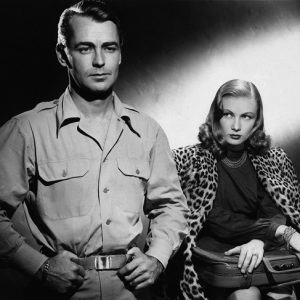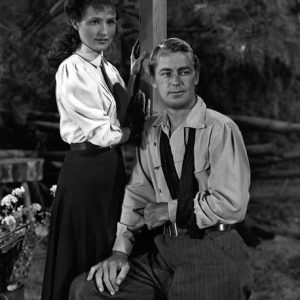calsfoundation@cals.org
Alan Ladd (1913–1964)
aka: Alan Walbridge Ladd Jr.
Alan Walbridge Ladd Jr., a native of Hot Springs (Garland County), was a movie actor who rose from poverty and starred in forty-seven films, mostly in the 1940s and 1950s. He often portrayed a solitary hero with a conscience and is best known for his title role in the classic western Shane (1953). He is the father of actress Alana Ladd, actor/producer David Ladd, and producer Alan Ladd Jr., one-time president of 20th Century Fox and co-founder of the Ladd Company.
Alan Ladd was born on September 3, 1913, to the American-born Alan Ladd Sr., a freelance accountant who traveled frequently, and the petite Selina Rowley Ladd (stage name Ina Raleigh), who was born in County Durham, England, in 1888 and came to the United States in 1907. They married in Hot Springs in 1912, but it is not known how the couple met or came to settle in Arkansas.
In 1917, when young Ladd was four, he saw his father fall over and die from a heart attack. While there was a small amount of insurance money to tide them over, the poverty-stricken mother and son lived in a rundown apartment building in Hot Springs, while Ina, without family or close friends, tried to decide what to do. On July 3, 1918, four-year-old Alan found a box of matches to play with and burned down the shabby apartment building the Ladds lived in.
Without furniture or possessions, Ina took what little money she had and moved with Alan to Oklahoma City. Ladd was a frail child, and when he entered school, he was the smallest in his grade and was subjected to relentless teasing about his size. Ina remarried to a frequently unemployed house painter named Jim Beavers. Unable to find work to support the family in Oklahoma City, they decided to move to California in 1920. Ladd later said it was like John Steinbeck’s The Grapes of Wrath, taking them four months to make the journey in a broken-down Model T. He also remembers constantly being hungry, as the family was too poor to buy food. Beavers was forced to sell his paintbrushes to pay for the frequent car repairs. Reaching California, they moved from a transient camp in Pasadena to Hollywood, where Beavers found a short-lived job painting movie sets for a soon-to-be defunct studio. Ladd remembers the family subsisting on potato soup for weeks on end.
When Ladd was twelve, he became ill with stomach ailments brought about by malnutrition. Due to this illness, the time spent making the trip west, and the family’s finding a permanent place to live, Ladd fell several grades behind in school. He was the oldest boy in his class but also, at 4′ 9,” the smallest. His classmates nicknamed him “Tiny,” which he hated. When he was fourteen, Ladd took a part-time job hauling produce crates for a grocery store, gradually building up his strength and muscles.
In 1930, he enrolled in North Hollywood High School and showed a talent in track and swimming. He won awards for swimming and diving at North Hollywood High and, in 1931, at age seventeen, went into training to be eligible for the 1932 Olympics. However, during a high dive in practice, he hit his head and was knocked unconscious, and he quit the sport when he found he could no longer concentrate on form due to worrying about another injury.
A teacher at North Hollywood High, Isabel Gray, persuaded him to take part in the school production of The Mikado, which he enjoyed. A classmate who was also in the show introduced him to her sister, Marjorie Jane “Midge” Harrold, whom he later married.
On February 1, 1934, Ladd graduated from North Hollywood High at age twenty, with a height of 5′ 4″. Borrowing $150, he opened a small hamburger and malt shop in North Hollywood across from the local pool, hoping his reputation as a former swimming star would help business. He called it “Tiny’s Patio,” possibly to preempt potential ridicule from his former classmates. However, it closed within a year, and he was again without income.
He then got a job at Warner Bros. film studio as a grip for $42.50 a week and took acting classes, financed by a friend of his mother because he could not afford the tuition. In October 1936, still struggling for success, he married the 5′ 1″ Marjorie Jane “Midge” Harrold, a brown-eyed blonde who bore a striking resemblance at the time to Cheryl Ladd, the future wife of his son David.
On October 22, 1937, their first son, whom they named Alan Ladd Jr. (called “Laddie”) was born, which was curious as Ladd himself was already a “Junior.” Ladd’s destitute mother, by then a widow and an alcoholic, moved in with them in their small, shabby apartment with its second-hand furniture. Three months later, on November 29, 1937, Ina committed suicide by swallowing ant poison, dying an agonized death before her son’s horrified eyes.
Initially turned down as an actor by motion picture studios because of his light skin and blond hair (which was felt not to photograph well), as well as his short stature (at this time 5′ 6″), he played small parts in local radio productions, working to improve his voice until he progressed to national presentations broadcast from Hollywood, such as “Lux Radio Theater.” Talent agent and former starlet Sue Carol heard him on the radio, liked what she heard, and offered to sign him to a contract. Ten years older than Ladd, she later said, “He came into my office wearing a long white trench coat. His blond hair was bleached by the sun. He looked like a young Greek god and he was unforgettable.” Through her efforts, he was cast in an uncredited role as a reporter in the 1941 movie Citizen Kane. His role as the hired killer Raven in the film This Gun for Hire (for which his hair was dyed black) won him instant fame in 1942. That same year, he divorced his wife Midge and married his agent Sue Carol a week later. They had two children, Alana (born 1943) and David (born 1947).
After initially being classified 4-F in World War II due to stomach problems, Ladd was later instructed to begin military service in January of 1943. He joined the Army Air Forces and sent to a camp at Walla Walla, Washington, attaining the rank of corporal. But in mid-November 1943, he was given an honorable medical discharge due to recurring stomach problems.
In December 1945, Alan and Sue went on a goodwill tour of Army bases and hospitals, including Camp Robinson in North Little Rock (Pulaski County). They decided to travel to Hot Springs to find people who had known his parents, but no one he talked to remembered them.
He starred in the movies Two Years Before the Mast, The Blue Dahlia, O.S.S. (all in 1946), and The Great Gatsby in 1949. His starring role in 1953’s Shane was said in the New York Times to be “one of the best performances ever given in a Western movie.” He received the Photoplay Gold Medal for the most popular performance of 1953 for Shane (along with Marilyn Monroe for Gentlemen Prefer Blondes). His handprints and footprints were added to Grauman’s Chinese Theatre in 1954.
His success in Shane was followed by roles in such films as The Big Land (1957), All the Young Men (1960), Boy on a Dolphin (1957), and The Carpetbaggers (1964). He appeared in a total of eighty films during his career, with leading ladies including Sophia Loren, Olivia de Havilland, and especially the 5′ 2″ Veronica Lake, a popular pairing that lasted through four pictures. He began his own production company, Jaguar Productions, in 1954. In 1957, he purchased an office building at 9250 Wilshire Boulevard in Los Angeles, which is still known as the Alan Ladd Building. He also bought several hundred acres in Palm Springs, California, where his home is still on the tour of stars. At the height of his fame, he was one of the few male stars whose face on a magazine cover ensured its success. Publisher Albert Delacorte said, “Alan Ladd sold magazines.”
Throughout his years of success, he suffered a series of illnesses, such as shingles, as well as accidents, including (while playing football with his son) an injury to his hand that became infected and developed gangrene; it almost had to be amputated. He also suffered from insomnia and found the combination of sedatives and alcohol helped him sleep and eased the pain.
On November 2, 1962, he was found with a self-inflicted gunshot wound to his chest, which he said was accidental. On January 29, 1964, at age fifty, Alan Ladd was found dead at his Palm Springs home of an overdose of sedatives and alcohol. He is buried at Forest Lawn Cemetery in Glendale, California. His star appears on the Hollywood Walk of Fame at 1601 Vine Street. He also has a star on the Palm Springs Walk of Stars, where he was added in 1995, and the Arkansas Walk of Fame in Hot Springs, where he was added in 1997. He was inducted into the Arkansas Entertainers Hall of Fame in 1996. Ladd’s son Alan Ladd Jr. went on to become an Oscar-winning producer and studio boss who had a hand in numerous iconic films.
For additional information:
Henry, Marilyn. The Films of Alan Ladd. New York: Citadel Press, 1981.
Hotchner, A. E. The Day I Fired Alan Ladd and Other World War II Adventures. Columbia: University of Missouri Press, 2002.
Linet, Beverly. Ladd: The Life, the Legend, the Legacy of Alan Ladd. New York: Arbor House, 1979.
Nancy Hendricks
Arkansas State University
 Arts, Culture, and Entertainment
Arts, Culture, and Entertainment World War II through the Faubus Era, 1941 through 1967
World War II through the Faubus Era, 1941 through 1967 Alan Ladd and Veronica Lake
Alan Ladd and Veronica Lake  Alan Ladd and Brenda Marshall
Alan Ladd and Brenda Marshall 




His western movie as a lumber entrepreneur was Guns of the Timberland (1960). Happy ending.
I was a fan of Alan Ladd and did a little research into the birth of his English mother. She is often listed as Ina Raleigh (her stage name) of Westchester, UK; however, she was born Selina Rowley at Chester-le-Street, County Durham. Her birth registration is in the March quarter of 1889, which suggests a birth date of late 1888 or early 1889. The U.S. census for 1910 confirms her first name as Selina.
Her parents were Charles John Rowley and Kate (Dee), who married in Newcastle in 1879.
In the 1891 UK census, she is listed as Salina, at home with her mother at Byker, Northumberland. Her father is not listed. In 1901, Selina is listed as a resident at All Saints Industrial School for homeless children, Newcastle.
Her mother died in 1902 and her father in 1916. She must have emigrated alone to the United States. It is possible she traveled to America with a theatrical group.
One on the best western movies that Alan Ladd starred in was Shane. I remember seeing the movie when I was a young man. That movie still is one of my favorites. I saw it the other night on TCM and enjoyed watching it again.. The movie was very well done, and I would watch it again. It had all the aspects that movies of today do not have–great actors that were well suited for their roles. They don’t make movies like that anymore; it was one of a kind. I really enjoy watching some westerns. The good guy always wins. I wish they would make more westerns like Shane. Alan Ladd was perfect as Shane.